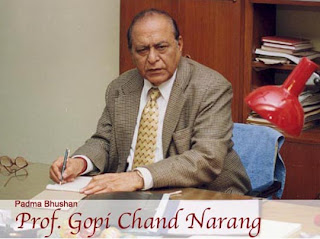The Vice President of India Shri M. Hamid Ansari presented the “Moortidevi Award for 2010” to eminent Urdu scholar Prof. Gopi Chand Narang for his outstanding work ‘Urdu Ghazal aur Hindustani Zehan wa Tehzeeb” at a function organized by Bhartiya Jnanpith here today. He congratulated Prof. Narang for receiving this award which he so rightly deserves. He also lauded the Selection Board which has chosen a litterateur whose work fully reflects the purpose and objectives for which the award was instituted.
Shri Ansari said that Prof. Narang revived Urdu language in our country through his writings and he is one of the foremost theorist, literary critic and Urdu scholar of our country. His perceptive writings have helped Urdu criticism becoming more contemporary. It is befitting that his long academic life of excellence has been felicitated by conferring the Moortidevi award on him. He thanked Bharatiya Gyanpith for inviting him at the function to give away the Moortidevi Award to Professor Narang.

Comments
Post a Comment